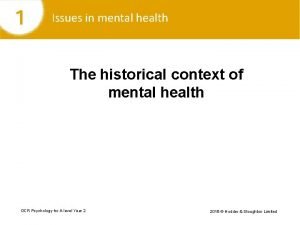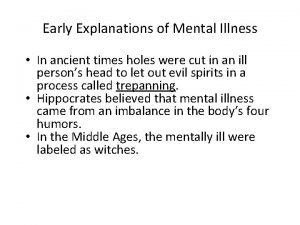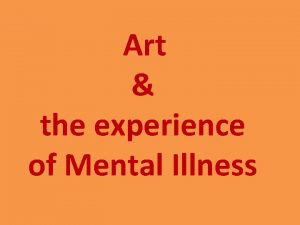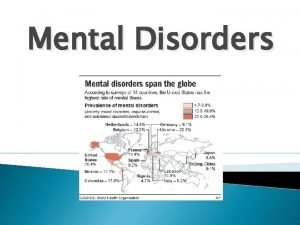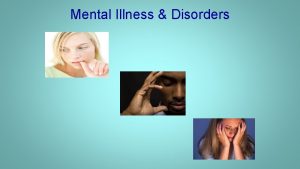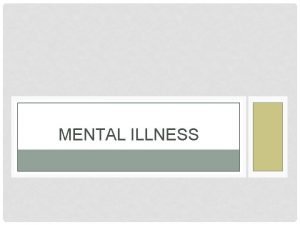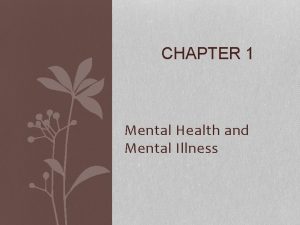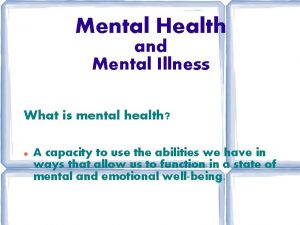MENTAL HEALTH ILLNESS AND DISORDERS DEVELOPMENTAL LEARNING DISORDERS











- Slides: 11

MENTAL HEALTH ILLNESS AND DISORDERS, DEVELOPMENTAL LEARNING DISORDERS AND NEUROCOGNITIVE DISEASE PROGRAMS State of Arizona Office of the Attorney General 1275 W Washington ST Phoenix, AZ 85007 -2926 PROJECT #AAGO 16 -00006015 Preparing a Logic Model and Gantt Chart: Technical Assistance Webinar for RFGA Response Submission Presented by: Timothy Mechlinski, Ph. D Senior Advisor Crestline Advisors tim@crestlineadvisors. com

Goals of this Presentation 1: To describe the general purpose of Logic Models and Gantt Charts 2: To review the templates that must be used when submitting attachments for this RFGA 3. Provide helpful examples of a Logic Model and Gantt Chart

I: Introduction to Logic Models* A Logic Models is: 1. A high-level depiction of how materials put into a process or program lead to the creation of outputs and achievement of desired results 2. A road map of a process or program, highlighting theory an organization believes will lead to beneficial outcomes *Based on materials of the Alliance of Arizona Nonprofits

Logic Model Terminology Inputs: Resources and contributions invested in the program (examples: staff, financing, equipment, partnerships, etc. ) Outputs: Activities implemented and products created by the program (examples: training sessions, counseling provided, participants served, etc. ) Outcomes: Impact of the program in both short-term and medium/long term time frames in terms of the value or changes for participants and communities (examples: changes in knowledge, behavior and skills, reduction in costs, etc. )

Required Logic Model Format

Sample Logic Model

II. Introduction to Gantt Charts A GANTT Chart is: 1. A visual representation of a project schedule. A type of bar chart, Gantt charts show the start and finish dates of the different required elements of a project. 2. A useful planning tool to show long a project should take and help to sequence required activities by laying them out in the order in which the tasks need to be completed

GANTT Chart Structure Goals and Activities: Each overall project goal is listed on the vertical axis followed by all of the specific activities that will take place to achieve that goal. (These goals should correspond directly to the outcomes presented in the Logic Model). Time Span: Presented on the horizontal axis. Each cell corresponds to roughly one business week. Each cell is shaded if an activity is planned to occur during that period.

Required Gantt Chart Format

Sample GANTT Chart

Review Used together, a Logic Model and a Gantt Chart can help Offerors to demonstrate a high level of planning and attention to detail that will allow for the successful achievement of desired results. Both the Logic Model and Gantt Chart submitted as attachments to the RFGA are required and must follow the specified format to allow for objective evaluation of their strength by reviewers.
 Mental health and mental illness chapter 20
Mental health and mental illness chapter 20 Jeopardy mental health
Jeopardy mental health Chapter 21 mental health diseases and disorders
Chapter 21 mental health diseases and disorders Mental health disorders
Mental health disorders Recognize developmental disorders of the dentition
Recognize developmental disorders of the dentition Historical views of mental illness psychology ocr
Historical views of mental illness psychology ocr Fair housing act mental illness
Fair housing act mental illness Mental illness in ancient times
Mental illness in ancient times Personality disorder vs mental illness
Personality disorder vs mental illness Mark rothko mental illness
Mark rothko mental illness Catherine earnshaw mental illness
Catherine earnshaw mental illness Americanization of mental illness
Americanization of mental illness





